|
|
Hampton

|
|
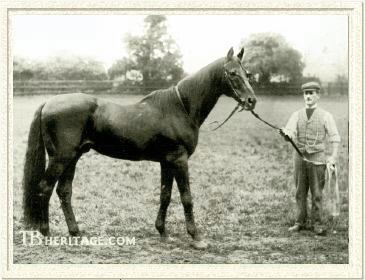 |
|
|
Hampton was a horse with a high class pedigree and a poor race record, until he finally matured into a solid winning stayer with great weight-carrying ability. He became a stallion of significant influence and a source of stamina, siring numerous classic champions and founding a powerful branch of the Stockwell male line.
Hampton was bred by Lord Norreys, later created Lord Abington, and was foaled at his breeder's farm, Tetsworth, near the ancient university town of Oxford, in 1872.
|
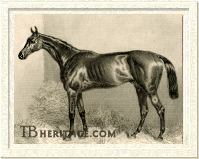
Lord Clifden
| |
Hampton was by Lord Clifden, a son of Newminster from the Melbourne mare The Slave. Lord Clifden had been a winner of the classic St. Leger, as had his sire, Newminster. The latter was an impeccably bred individual, being by Touchstone, another St. Leger champion and the pre-eminent stallion of his era. Dam of Newminster was the celebrated racemare Beeswing. Lord Clifden continued the impeccable siring record of his male line, as during his stud career he sired four classic winners, all of whom numbered the St. Leger among their triumphs--Hawthornden and Wenlock, winners of the St. Leger; Petrarch, winner of the Two Thousand Guineas, St. Leger and Ascot Gold Cup; and Jannette, winner of the Oaks and St. Leger.
|
Hampton was the first foal from his dam, the Kettledrum mare Lady Langden. Though she never raced, Lady Langden had a pedigree which made her a highly desirable broodmare prospect, for her sire was a Derby winner, her dam had previously produced the St. Leger winning filly Caller Ou to the cover of Stockwell, and her second dam was the fabled matron, Queen Mary. That mare had produced Derby and Oaks heroine Blink Bonny, herself dam of Derby hero Blair Athol. Queen Mary also foaled major stakes winners Broomielaw and Blinkhoolie, as well as Bonnie Scotland, a stallion who went on to found an important male line after his exportation to the United States. As if all this was not enough, Lady Langden later foaled a Derby winner in Sir Bevys, a son of Favonius.
Clearly, Hampton was bred to be a high class animal. Distance was to prove no problem for him, with so many St. Leger champions in his family tree. Yet, this wealth of stamina hindered his early development, as Hampton was slow to mature. Added to the fact that he was small, he was not highly regarded as a young colt. In fact, for his first few races, he was not even named. In October of his juvenile season, he won the South-Western Stakes, a selling race, and was subsequently purchased by James Nightengall for 200 guineas.
Nightengall named his new colt Hampton in honor of the racecourse where the South-Western Stakes had been run. Nightengall ran the colt in another selling race, but managed to keep him for 150 guineas. Hampton won this little race, as well, to have an unbeaten record in a maiden race and two selling races. But he had shown some spark of ability to warrant being tried against higher competition. His last two races of the season were in nurseries, in one of which he finished third and the other unplaced. Based on this record, it was obvious Hampton was well below the form of the best of his generation, and was not even considered for the next season's classic events.
As a three-year-old, Hampton managed to win only two of five starts, his most important victory coming in the 2-1/4 mile Great Metropolitan Stakes at Epsom in which he toted only 87 pounds. No one would have dared mention the name Hampton in the same sentence as that year's Derby hero, Galopin, until years later, when both were enjoying careers as fashionable stallions.
During the off season, Hampton was started in some races over hurdles, winning one maiden race. A disagreement over training fees led to the dismissal of Nightengall's trainer, Mr. Harvey. Hampton was transferred to the care of the highly successful trainer Robert Peck, who had, two years earlier, won the Derby with Doncaster, and the St. Leger with Marie Stuart, both owned by James Merry.
Hampton had begun to mature physically. The colt was tried against some very good members of Peck's yard and acquitted himself so well that Peck was brimming with confidence for the 2-1/2 mile Goodwood Stakes. The works were kept low key, so Hampton got in the race with only 108 pounds and won by less than a length. Hampton started only two more times that season, finishing fourth in both the Doncaster Cup and the Cesarewitch. The results were promising, for Peck was convinced his charge had not yet reached his full potential, and with careful nurturing over the winter, his hunch was born out. Hampton blossomed into a truly magnificent handicap performer over the next two seasons.
At five, Hampton captured eight of ten races, losing only the Goodwood Stakes and the Great Ebor Handicap. His victories came in the Northumberland Plate, the Goodwood Cup (in which he defeated classic winner Petrarch, who ran fourth), the Doncaster Cup, the Kelso Gold Cup, and the Caledonian Centenary Cup. He also participated in three Queen's Plates, one of which was a walk-over. No longer was Hampton the lightly-weighted longshot. He proved himself a genuine stayer, and successfully toted 133 pounds in the Doncaster Cup, 139 pounds in the Kelso Gold Cup, and 138 pounds in the Caledonian Centenary Cup.
Before he raced as a six-year-old, Hampton was purchased for 7200 guineas by Francis Egerton, 3rd Earl Ellesmere. He ran in ten races and won half of them. His most important victory came in the Epsom Gold Cup, and he ran decent, albeit, losing efforts in the Goodwood Stakes, Ascot Gold Cup and Jockey Club Cup. One of his most courageous performances was in the Cambridgeshire Handicap: weighted with 129 pounds, he ran fourth to Isonomy in a field of thirty four, conceding that opponent thirty pounds. In the Jockey Club Cup, Hampton was burdened with 140 pounds, finishing fourth.
Hampton in the Stud
All told, Hampton won 19 of his 33 races and stamped himself as a weight carrier and stayer of exceptional merit. Possibly because of this, it was not expected that his offspring would be precocious. Thus he began his stud career at a modest fee of 30 guineas at Worseley Hall near the city of Manchester. As he became more popular, Hampton was moved to his owner's stud at Newmarket, Stetchworth, and accordingly, his fee rose, eventually reaching 150 guineas. He was leading sire in England in 1887, and he was often in the top ten on the sire's lists in other years. Hampton sired four classic winners: Merry Hampton, Reve d'Or, Ayrshire, and Ladas, and a number of other high-quality youngsters who won good races in England. He transmitted his staying ability to a number of them, and that characteristic persisted in many of his descendants for generations.
|
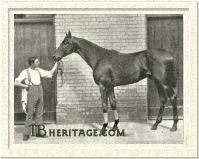
Merry Hampton | | MERRY HAMPTON, out of Doll Tearsheet, by Broomielaw, has sometimes been criticized as one of the worst winners of the Derby. His only victory came in the Derby, though he did finish second in the St. Leger. He might have won that classic, too, had he not been boxed in badly, for when free, he ran the winner Kilwarlin to within half a length. The harsh assessment of Merry Hampton as a racer in some quarters is not quite fair, for he had talent. Merry Hampton was an unsound colt, which made him difficult to train. In fact, the Derby was the first race of his abbreviated career, which was hampered by his delicate legs.
|
| As a sire of racehorses, Merry Hampton was a failure. He got only one decent runner, the colt Pride, who raced just as a four-year-old and gained distinction by defeating the star French runner Omnium in the Alexandra Plate. Merry Hampton's daughter, Merry Wife, became the dam of 1901 Ascot Gold Cup winner Santoi. Another daughter, Merry Token, was exported to America by August Belmont, assuring her sire some measure of immortality, for through her, he became the broodmare sire of Mahubah, the Rock Sand filly destined to become the dam of the incomparable Man o' War and ancestress of American Triple Crown champion Assault.
|
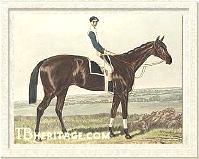
Ayrshire
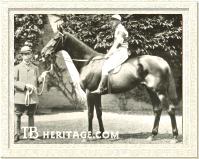
Ladas | |
AYRSHIRE, out of Atalanta, by Galopin, was bred and raced by the Duke of Portland. Ayrshire was a top performer all three seasons he ran, winning many important races, including the Champagne Stakes at two, the Two Thousand Guineas and Derby at three, and the Eclipse Stakes at four.
At stud, AYRSHIRE was noted for the quality of his fillies over his colts. His two classic winners were fillies--Oaks winners Airs and Graces and Our Lassie. Daughters of Ayrshire made wonderful producers. Daughter Gas produced Derby champion Cicero; Glare produced One Thousand Guineas heroine Flair and also became the second dam of Prince Palatine; Cannie Lassie produced One Thousand Guineas winner Witch Elm. St. Leger winner Night Hawk and One Thousand Guineas winner Roseway were also products of Ayrshire mares. Ayrshire's best son was Robert Le Diable, winner of several races, including the City and Suburban Handicap and Doncaster Cup. Robert le Diable sired Wrack, a stallion who did well in the United States as the sire of thirty stakes winners.
|
LADAS, out of Illuminata, by Rosicrucian, was a lovely animal with a superb pedigree. Third dam Paradigm was a half sister to the dam of Bend Or. His dam Illuminata would later produce One Thousand Guineas winner Chelandry as well as Gas, dam of the aforementioned Derby winner Cicero.
Bred and raced by Archibald Philip Primrose, 5th Earl of Rosebery, LADAS was unbeaten at age two, winning the Woodcote Stakes, Coventry Stakes, Champagne Stakes, and the Middle Park Plate. At three, Ladas captured both the Two Thousand Guineas and Derby and placed in the Eclipse Stakes, Princess of Wales's Stakes, and the St. Leger.
At stud, LADAS was somewhat disappointing, as he did not yield a son which carried his line forward. But he did get Epsom Lad, winner of the Eclipse Stakes; Gorgos, winner of the Two Thousand Guineas and July Stakes; and Troutbeck, winner of ten races including the St. Leger. None of these became very notable sires.
Montem was a speedy daughter of LADAS which captured the New Stakes at Ascot and the July Stakes. Baroness La Fleche, another filly by ladas, was exquisitely bred, being from St. Simon's classic-winning daughter La Fleche. She won the Acorn Stakes at Epsom, but was more noted as a broodmare, as she produced Cinna, a Polymelus filly who won the One Thousand Guineas and placed second to Charlebelle in the Oaks. Cinna became the dam of Beau Pere, a leading sire in New Zealand and the United States.
|
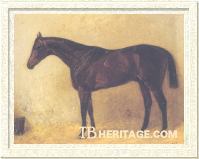
Ladislas | | Other good running sons sired by Hampton included LADISLAS, who was the top of his generation, winning the Dewhurst Stakes, the King Edward VII Stakes and the Jockey Club Cup; DUKE OF RICHMOND, who won the Richmond Stakes; GRANDISON, winner of the Champagne Stakes and the Windsor Castle Stakes; GAY HAMPTON, winner of the Craven Stakes; LORD LORNE, a great stayer, who won the Ascot Stakes twice; FITZ HAMPTON, another good stayer, who, in Italy, won a number of races, including el Premio Presidente de la Republica over 2,400 meters, and the Gran Premio de Milan; BALMORAL, winner of the Manchester Cup; BUSHEY PARK, winner of the Queen Alexandra Stakes, PHOCION, who won the St. James Palace Stakes and the Kind Edward VII Stakes; TROON, another St. James Palace Stakes winner; SPEED, winner of the July Stakes.
|
Hampton had three other good sons who were good racers, and also very good sires--Royal Hampton and Bay Ronald, the latter of whom perpetuated the Hampton male line well into the twentieth century. The third, Sheen, lived to a great age, siring foals to the end of his life.
ROYAL HAMPTON was produced from the King Tom mare Princess, and bred by famed breeder William Blenkiron. Royal Hampton suffered a serious foot injury as a foal in which his foot became lodged in a stall door, the effects of which stayed with him throughout his life, as he was a very unsound horse. Nevertheless, Sir Blundell Maple liked the colt and purchased him for his stable.
|
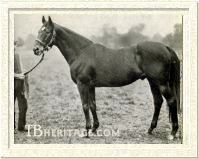
Royal Hampton | | ROYAL HAMPTON ran ten times during his career and only won twice--on his debut in the National Breeders Produce Stakes at two and in his last race, the City and Suburban Handicap at four. In the latter race, the colt's fragile legs gave way, but he still managed to win the race on heart. In between, Royal Hampton secured placings in a host of important races--the Woodcote Stakes, Champagne Stakes, Middle Park Plate, the Derby, Prince of Wales Stakes, and Sussex Stakes. Only once was Royal Hampton unplaced. He was a courageous and honest campaigner, and after his career-ending injury, he was retired to Sir Maple's Childwick Bury Stud.
|
As a stallion, ROYAL HAMPTON did better than expected. His female family was not a strong one, but he nevertheless came up with two top class winners--Kirkconnel, winner of the Two Thousand Guineas and Marcion, a winner of the Ascot Gold Cup. Neither of these excelled as stallions. In fact only one son of his made a name for himself, that being Royal Lancer, who became a decent sire in Australia.
ROYAL HAMPTON'S most notable daughter was Royal Rose. Imported to the United States by James R. Keene, Royal Rose became the dam of major stakes winners Pennant, Transvaal, Iron Mask, and Lancastrian, and through her daughter, Cherokee Rose, a full sister to Pennant, became matriarch of a family which through the years has produced such luminaries as Sweep, John P. Grier, Sunreigh, Bewitch, First Fiddle, High Voltage, Red God, Terlingua, Ruffian, Storm Cat, Pine Bluff, and Fusaichi Pegasus. Stefan the Great, Flying Ebony, and Omar Khayyam each had Royal Hampton mares as their second dams.
Joe Palmer, in his book Names in Pedigrees, relates a touching story on Royal Hampton and his owner:
" Sir Blundell Maple was justly very fond of his stallion. Not long before the owner's death, he expressed a wish to see the horse again, and Ernest Prentice, his stud groom, paraded Royal Hampton across the lawn at Childwick Bury, while two attendants brought Sir Blundell to a window for a final look at his favorite."
Sir Blundell died soon after, and Royal Hampton died two years later, in 1906, and was buried near the grave of his devoted owner.
|
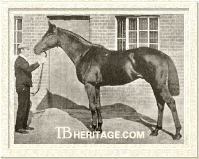
Sheen
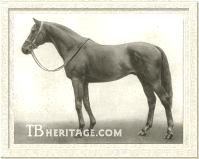
Bay Ronald |
|
SHEEN, a bay son of Hampton from the Tibthorpe mare Radiancy, was bred by Prince Saltykoff and foaled in 1885. He was a high class campaigner, but not quite up to classic standard. At three, he won the Ascot Derby and placed third in the Sussex Stakes. At four, he captured the important Jockey Club Cup, and at five, the Cesarewitch Handicap. At stud, his best representative was Batt, a half-brother to Flying Fox. Batt was narrowly defeated by the longshot Jeddah in the 1898 Derby Stakes. Sheen was a long-lived and active stallion, and was still covering mares in Scotland, at a fee of nine guineas, in 1915 at the age of 30.
BAY RONALD was foaled in 1893, when Hampton was 21-years-old, and he was the son which kept the line of his sire in the limelight for many more succeeding generations. Bay Ronald was produced from the mare Black Duchess, a daughter of Two Thousand Guineas winner Galliard, a son of Galopin. Many years later, this female family would become famous when the stallion Blandford became a leading sire in the late 1920s and early 1930s. Blandford was a son of Blanche, whose dam, Black Cherry, was a half-sister to Bay Ronald. |
Bay Ronald, foaled in 1893 at Leybourne Grange Stud and was bought privately by Mr. (later Sir) Leonard Brassey on the recommendation of Tom Jennings, Jr., son of the trainer of the great French runner, Gladiateur. Jennings, Jr. trained this son of Hampton, and like others of his tribe, he was slow to mature. BAY RONALD won the Lowther Stakes and the Limekiln Stakes at age three, and the Hardwick Stakes and the City and Suburban Handicap among eight other wins between the ages of four and six. He stood at Preston Farm near Aylesford, and after six years was sold to France, where he died at the early age of fourteen.
He left Dark Ronald, born in England, who sired the great stayer and progenitor Son-in-Law, whose male line descendants included Beau Pere, Foxlaw, Foxhunter, Bosworth, Herbager, Marsyas II, Ambassador IV, Prunus, Oleander, and a number of other good race horses and influential sires.
Another Bay Ronald son, Bayardo, won 22 of his 25 starts over three years, and in the stud sired two winners of the English Triple Crown, Gay Crusader and Gainsborough, the latter later the sire of Hyperion and Solario, among others. A Bay Ronald son born in France, Macdonald II, won the Prix Royal Oak (French St. Leger) and became an influential sire in France. Bay Ronald's daughter, Rondeau, became the dam of the great stallion Teddy, whose offspring included Sir Gallahad III, Bull Dog, and the influential broodmare La Troienne.
|
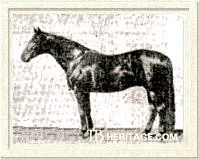
Star Ruby | | Another son of Hampton, gotten, like Bay Ronald, when his sire was in his advanced years, was STAR RUBY. He was foaled in 1892, out of the Bend Or mare Ornament. The colt was sold to American horseman Green Morris and sent to America. He was a useful runner, but more successful as a stallion. Purchased by James Ben Ali Haggin, Star Ruby stood at stud in California. He got two American classic winners, Cairngorm, a winner of the Preakness, and Africander, a winner of the Belmont Stakes, Suburban Handicap, Saratoga Cup, and the Lawrence Realization. STAR RUBY'S son Rubio was a chestnut colt sent to race in England, where in 1908, he became the first American-bred to capture the Grand National Steeplechase at Aintree. STAR RUBY'S daughter, Ruby Nethersole, became the second dam of Questionnaire. |
Hampton's Daughters
Hampton's best running daughter was REVE D'OR, out of Queen of the Roses, by Sundeelah. She was kept in training an unusually long time for a classic winning filly, for she raced until she was seven. As a juvenile, she captured the Dewhurst Plate. At three, Reve d'Or was a dual classic champion, for she won both the One Thousand Guineas and the Oaks, as well as the Yorkshire Oaks. During her career, she won eleven other races, including the Sussex Stakes, Jockey Club Cup, and the City and Suburban Handicap.
As a broodmare, Reve d'Or failed to come up with anything remotely like herself. She spent her producing career in France, and one of her daughters, Oussouri, became the dam of a good performer named Opott II, winner of several stakes races in France and placed in the Grand Prix Prix de Paris. Opott II went on to sire L' Olivete, dam of Mieuxce. |

Butterfly | | Other good Hampton daughters on the turf included ROOKERY, from an Oxford mare, who won the Windsor Castle Stakes; BELINDA, a great staying mare who won the Park Hill Stakes and the Ascot Stakes over 4,023 meters; MAIZE, a sister of St. Florian, out of Palmflower, won the Nassau Stakes; BUTTERFLY, whose dam was Merry Duchess by Speculum, won the Nassau Stakes and the Coronation Stakes and ran third in the Doncaster St. Leger, among her other placings; RAMBLING KATIE, from the Galliard daughter Barmaid, won the 2,414 meter Manchester Cup; HAWAMDIEH, out of the Galopin daughter Boyne Water, won the 2,200 meter Prix de la Rochette. |
|
As a sire of broodmares, Hampton boasted some impressive representatives, including Perdita II and Maid Marian. PERDITA II, out of Hermione, by Young Melbourne, was a temperamental mare, and transmitted her nervous energy to her offspring. She was a moderately successful race mare of staying class, winning the Ayr Gold Cup, the Liverpool Cup, and the Great Cheshire Stakes (twice). Purchased by Albert Edward, Prince of Wales (afterward King Edward VII) for 900 guineas, Perdita II went on to become the jewel of the Prince's broodmare band. To the cover of St. Simon, she produced three extraordinary full brothers--Persimmon, Florizel II, and Diamond Jubilee. All three were top racehorses, and good sires. Persimmon sired five classic winners and was twice leading broodmare sire in England. Florizel II was among the leading sires seven times in England, and also was a good broodmare sire; he got three classic winners. Diamond Jubilee won the English Triple Crown, and after export to Argentina became the leading sire there four times. |
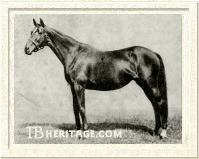
Perdita II, dam of three extraordinary sons | | Hampton's daughter MAID MARIAN, foaled in 1886, became the dam of one the most influential British stallions of the twentieth century--Polymelus. Out of the Toxophilite mare Quiver, Maid Marian was bred by Queen Victoria and was a product of the Hampton Court Stud. As a racehorse, Maid Marian proved useless, as she started only as a two-year-old, running seven times without notching a single victory. Maid Marian's value as a broodmare went up considerably due to the exploits of her younger half sisters--Memoir and La Fleche--classic winning daughters of St. Simon. Maid Marian was owned by the Earl of Crewe when she was covered by Cyllene in 1901 and foaled the bay colt Polymelus the following spring. |
|
Winner of eleven of his thirty-one races, including the Duke of York Stakes twice, and the Cambridgeshire Handicap, Polymelus retired to the stud of S.B. Joel. Polymelus led the English sire's list five times and was second twice: he sired five classic winners, including the English Triple Crown champion, Pommern, and got the extremely significant sire son, Phalaris.
|
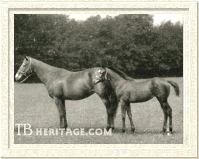
Gadfly | |
Hampton's daughter, FOTA, produced 1907 Oaks heroine Glass Doll to the cover of Isinglass, while another daughter of Fota, Angelic, became the dam of leading American sire, North Star III.
GADFLY, an 1896 sister to BUTTERFLY, out of Merry Duchess, won the Newmarket Oaks, and at age four, the Alexandra Plate and the Whip. She produced six winners, including Cylgad, winner of the Newmarket Stakes and later a sire, and Flying Bridge, who won the Newmarket Oaks.
|
Another Hampton daughter, BROAD CORRIE, out of Corrie Roy, by Galopin, became the dam of the Isinglass filly Glasalt. This filly, acquired by the Earl of Derby, became a pillar of the Derby stud. Glasalt herself produced Canyon, victress in the One Thousand Guineas, and became ancestress of such standout runners as Colorado, Oaks winner Toboggan, and American Triple Crown champion Citation. It is interesting to note that these two daughters of Hampton--Fota and Broad Corrie--each mated well with Isinglass. One produced a classic-winning filly to his cover, while the other produced a daughter who became matriarch of a very important family for one of the premier studs of Britain. Isinglass was out of a mare by Wenlock, a son of Lord Clifden, the sire of Hampton.
James R. Keene, master of Castleton Stud near Lexington, Kentucky, made a practice to import well-bred English mares to mate with his stallions--such as Domino, Ben Brush, and Commando. One of the mares imported by Keene was Hampton's daughter Hampton Belle, produced from the Breadalbane mare Silver Bell. Mated to Domino's son Disguise, the resultant foal was a filly. Named COURT DRESS, she became the American champion two-year-old filly of 1906, winning five of her six races, including the Fashion Stakes and Spinaway Stakes.
Hampton's daughter, LA VIERGE, an 1890 filly out of Elizabeth, by Statesman, showed poor form in her three races at age two. After arriving at J.B. Joel's stud in 1898, she produced four classics-placed runners; St. Leger second place finisher Prince William; Oaks-placed Verne; Two Thousand Guineas third place finisher and St. Leger runner-up Lycaon, who also won the Chester Cup; and St. Leger runner-up White Magic. She also produced Pure Crystal, winner of Ascot's King Edward VII Stakes, and Pure Gem, winner of the Alexandra Stakes.
Other Hampton daughters of merit in the breeding shed included: ROOKERY, who was the dam of Coventry Stakes winner The Deemater and of July Stakes winner Flyaway; LADY CLARENDON, dam of Yorkshire Oaks winner Fairmile and of Headpiece, winner of the Craven Stakes; HORS DE COMBAT, who was the dam of Gantlet, who won the Park Hill Stakes, the Imperial Produce Stakes, and the Yorkshire Stakes; the aforementioned MAIZE, dam of Mazagan, who won the Jockey Club Cup and the Goodwood Cup, and of Veronese, winner of the 2,615 meter Princess of Wales Stakes; HERMINIA, dam of Herminius, winner of the Ascot Stakes and the Manchester Cup; KISS ME, whose son Eryx won the Grand Criterium and the Prix de la Rochette in France; CINDER, dam of the great stayer Scullion, who won the Ascot Stakes and the Manchester Cup; LETICE, dam of Verdier, winner of the Grand Prix de Deauville; KIRSCHE, dam in Germany of Kreuzer, who won the Ratibor Rennen; HAMPTON BROOK, whose daughter Hellene won the Oaks in Chile and went on to found a great maternal line there which produced numerous classic winners. Many other Hampton daughters produced stakes winners as well.
Hampton rose from his status as an unnamed colt, winning minor races as a juvenile, to one of the most important stallions of his era. Unlike some of his descendants, Hampton lived a good, long life. On December 8, 1897, Hampton was humanely destroyed, having covered his last mares the previous year. He was 25-years-old.
--Liz Martiniak
|
|
|
|

